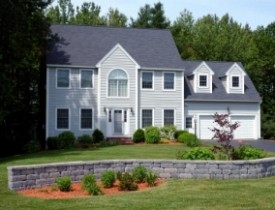The What, Why and How of Hardscaping

Hardscaping is a term for everything in the garden that is not living and growing. The most common hardscaping feature is paving -- either patios or walkways. However, hardscaping can also include walls, birdbaths, benches, large pottery and sculptures.
Hardscaping has aesthetic and practical value. It also can be used to delineate between garden areas, and to create balance and focus. Here is a guide to three basic hardscape elements.
Sculptures and Planters
A guiding principle of photography and graphic design is having a single main element to draw your eye. Landscape design is similar. A lush expanse of blooms and foliage might be carefully planned with complementary colors and sizes, but the yard can end up looking like a rainforest if there is no particular element to draw your eye. A large planter in the middle of the garden can become such an element. It also may add contrasts in color and texture. Sculptures add even more texture and style. On the other extreme, a large rock can also do the trick of serving as a focal element.
Retaining Walls
Walls add dimension to a garden. Try replacing the back end of the garden with two short walls, adding plants at each level. This lets you maintain a theme and put the same types of plant in various locations without creating a dull, uniform garden. Curved walls add a sense of motion, either by creating a terrace or adding a curving wall rising above garden areas on grade.
Walls also have practical purposes. They can hide an ugly foundation wall or a bare gray porch. They can protect delicate flowers from children running through the yard. Finally, they raise the soil surface. If planted correctly, walled garden areas will help slope the ground away from the house so water is not drawn into the foundation. At the same time, they retain water that would run off down a slope and be wasted.
The standard garden wall types are stacked concrete blocks on a gravel base, and stone walls with a gravel base or with the bottom level set below grade.
Paving
Paving can help divide garden areas, provide walkways that protect plants from trampling and protect shoes from mud. Of course, paving also creates patios and other outdoor living areas. Again, curved walkways create a sense of motion.
Paving can be as simple as cement paving bricks or as artistic as detailed patterns between flowerbeds using various colors and sizes of slate or exotic stone. Keep in mind that paving can create weeding and mowing headaches. One option is to set pavers below grade and leave enough space between for mowing. Otherwise, dig out the entire patio or walkway space, lay a weed barrier and add mortar, gravel or landscaping sand between pavers.
Paved paths and patios, garden walls and decorative stones and sculptures can all add character, beauty and practicality to your garden.
Looking for a Pro? Call us (866) 441-6648

Landscaping Average Costs
Landscapers Experiences

I Built A Concrete Retaining Wall As A Defense Against El Nino

Contracted A Large Tree Trimming Job For A Reasonable Price



